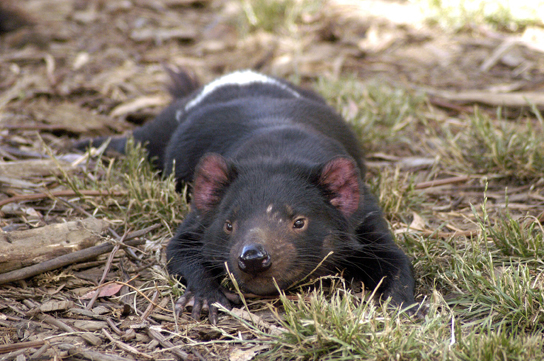29.6C: Living Mammals
- Page ID
- 13938
- Name and describe the distinguishing features of the three main groups of mammals
Living Mammals
Living mammals can be classified into three major classes: eutherians, monotremes, and metatherians. The eutherians, or placental mammals, and the metatherians, or marsupials, together comprise the clade of therian mammals. Monotremes form their sister clade.
There are three living species of monotremes: the platypus and two species of echidnas, or spiny anteaters. The leathery-beaked platypus belongs to the family Ornithorhynchidae (“bird beak”), whereas echidnas belong to the family Tachyglossidae (“sticky tongue”). The platypus and one species of echidna are found in Australia; the other species of echidna is found in New Guinea. Monotremes are unique among mammals as they lay eggs rather than giving birth to live young. The shells of their eggs are not like the hard shells of birds, but are leathery, similar to the shells of reptile eggs. All monotremes possess a cloaca which serves as the opening for the intestinal, reproductive, and urinary tracts. Additionally, monotremes have no teeth.
Marsupials are found primarily in Australia,although the opossum is found in North America. Australian marsupials include the kangaroo, koala, bandicoot,Tasmanian devil, and several other species. Most species of marsupials possess a pouch in which the very premature young reside after birth, receiving milk and continuing to develop. Marsupials differ from eutherians in that there is a less complex placental connection. The young are born at an extremely early age and latch onto the nipple within the pouch.

Eutherians are the most widespread of the mammals, occurring throughout the world. There are 18 to 20 orders of placental mammals. Some examples are Insectivora, the insect eaters; Edentata, the toothless anteaters; Rodentia, the rodents; Cetacea, the aquatic mammals including whales; Carnivora, carnivorous mammals including dogs, cats, and bears; and Primates, which includes humans. Eutherian mammals are sometimes called placental mammals because all species possess a complex placenta that connects a fetus to the mother, allowing for gas, fluid, and nutrient exchange. While other mammals possess a less complex placenta or briefly have a placenta, all eutherians possess a complex placenta during gestation.
Key Points
- Monotremes include the platypus which are defined by their ability to lay eggs instead of giving birth to live young.
- Metatherians are classified as the marsupials which possess a pouch where the premature young reside and nurse while continuing to develop.
- Eutherians are the most common type of mammal and are defined by the presence of a complex placenta which connects the developing fetus to the mother during gestation.
Key Terms
- marsupial: a mammal of which the female has a pouch in which it rears its young, which are born immature, through early infancy
- placental: a mammal having a placenta; most members of Mammalia
Contributions and Attributions
- OpenStax College, Biology. October 17, 2013. Provided by: OpenStax CNX. Located at: http://cnx.org/content/m44692/latest...ol11448/latest. License: CC BY: Attribution
- sebum. Provided by: Wiktionary. Located at: en.wiktionary.org/wiki/sebum. License: CC BY-SA: Attribution-ShareAlike
- sinoatrial node. Provided by: Wikipedia. Located at: en.Wikipedia.org/wiki/sinoatrial%20node. License: CC BY-SA: Attribution-ShareAlike
- integument. Provided by: Wiktionary. Located at: en.wiktionary.org/wiki/integument. License: CC BY-SA: Attribution-ShareAlike
- vibrissa. Provided by: Wiktionary. Located at: en.wiktionary.org/wiki/vibrissa. License: CC BY-SA: Attribution-ShareAlike
- diphyodont. Provided by: Wiktionary. Located at: en.wiktionary.org/wiki/diphyodont. License: CC BY-SA: Attribution-ShareAlike
- OpenStax College, Mammals. October 17, 2013. Provided by: OpenStax CNX. Located at: http://cnx.org/content/m44692/latest...e_29_06_01.jpg. License: CC BY: Attribution
- Heart diagram blood flow en. Provided by: Wikipedia. Located at: en.Wikipedia.org/wiki/File:He...od_flow_en.svg. License: CC BY-SA: Attribution-ShareAlike
- Ursus maritimus Steve Amstrup. Provided by: Wikipedia. Located at: en.Wikipedia.org/wiki/File:Ur...ve_Amstrup.jpg. License: Public Domain: No Known Copyright
- OpenStax College, Biology. October 17, 2013. Provided by: OpenStax CNX. Located at: http://cnx.org/content/m44692/latest/?collection=col11448/latest. License: CC BY: Attribution
- Evolution of mammals. Provided by: Wikipedia. Located at: en.Wikipedia.org/wiki/Evolution_of_mammals. License: CC BY-SA: Attribution-ShareAlike
- Eutheria. Provided by: Wikipedia. Located at: en.Wikipedia.org/wiki/Eutheria. License: CC BY-SA: Attribution-ShareAlike
- eutherian. Provided by: Wiktionary. Located at: en.wiktionary.org/wiki/eutherian. License: CC BY-SA: Attribution-ShareAlike
- metatherian. Provided by: Wiktionary. Located at: en.wiktionary.org/wiki/metatherian. License: CC BY-SA: Attribution-ShareAlike
- OpenStax College, Mammals. October 17, 2013. Provided by: OpenStax CNX. Located at: http://cnx.org/content/m44692/latest...e_29_06_01.jpg. License: CC BY: Attribution
- Heart diagram blood flow en. Provided by: Wikipedia. Located at: en.Wikipedia.org/wiki/File:He...od_flow_en.svg. License: CC BY-SA: Attribution-ShareAlike
- Ursus maritimus Steve Amstrup. Provided by: Wikipedia. Located at: en.Wikipedia.org/wiki/File:Ursus_maritimus_Steve_Amstrup.jpg. License: Public Domain: No Known Copyright
- OpenStax College, Mammals. October 17, 2013. Provided by: OpenStax CNX. Located at: http://cnx.org/content/m44692/latest...e_29_06_02.jpg. License: CC BY: Attribution
- OpenStax College, Biology. October 17, 2013. Provided by: OpenStax CNX. Located at: http://cnx.org/content/m44692/latest/?collection=col11448/latest. License: CC BY: Attribution
- Cloaca. Provided by: WIKIPEDIA. Located at: en.Wikipedia.org/wiki/Cloaca. License: CC BY-SA: Attribution-ShareAlike
- placental. Provided by: Wiktionary. Located at: en.wiktionary.org/wiki/placental. License: CC BY-SA: Attribution-ShareAlike
- marsupial. Provided by: Wiktionary. Located at: en.wiktionary.org/wiki/marsupial. License: CC BY-SA: Attribution-ShareAlike
- OpenStax College, Mammals. October 17, 2013. Provided by: OpenStax CNX. Located at: http://cnx.org/content/m44692/latest/Figure_29_06_01.jpg. License: CC BY: Attribution
- Heart diagram blood flow en. Provided by: Wikipedia. Located at: en.Wikipedia.org/wiki/File:Heart_diagram_blood_flow_en.svg. License: CC BY-SA: Attribution-ShareAlike
- Ursus maritimus Steve Amstrup. Provided by: Wikipedia. Located at: en.Wikipedia.org/wiki/File:Ursus_maritimus_Steve_Amstrup.jpg. License: Public Domain: No Known Copyright
- OpenStax College, Mammals. October 17, 2013. Provided by: OpenStax CNX. Located at: http://cnx.org/content/m44692/latest...e_29_06_02.jpg. License: CC BY: Attribution
- OpenStax College, Mammals. October 17, 2013. Provided by: OpenStax CNX. Located at: http://cnx.org/content/m44692/latest...e_29_06_04.jpg. License: CC BY: Attribution
- Vulpes vulpes sitting on a stone. Provided by: Wikimedia Commons. Located at: http://upload.wikimedia.org/wikipedi...g_on_stone.jpg. License: Public Domain: No Known Copyright


